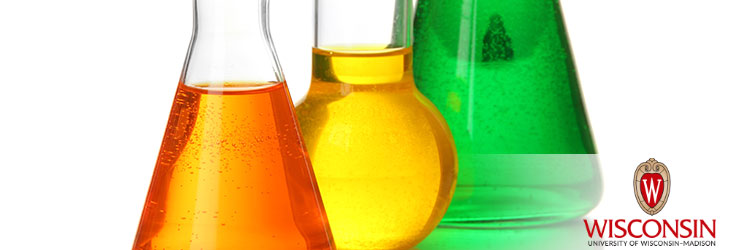Materials & Chemicals

Perovskites for Stable, High Activity Solid Oxide Fuel Cell Cathodes and Related Technologies
WARF: P160222US01
Inventors: Dane Morgan, Ryan Jacobs
The Wisconsin Alumni Research Foundation (WARF) is seeking commercial partners interested in developing perovskite compounds with the potential to outperform the best solid oxide fuel cell (SOFC) cathode materials known.
Overview
The rise of alternative energy technologies is driving materials R&D. Solid oxide fuel cells (SOFCs) may come to play an important role, as they are able to produce energy by direct chemical-to-electrical conversion of oxygen and hydrogen or hydrocarbon fuels with high efficiency and relatively little greenhouse gas emission. When operated in reverse, the fuel cell functions as an electrolyzer, effectively storing the energy obtained by splitting water in hydrogen and oxygen for future power generation.
Typically, SOFCs must be operated at high temperatures (800 – 1000 degrees Celsius), in part to overcome the slow kinetics of the oxygen reduction reaction (ORR) at the cathode. The slow kinetics of the ORR is a major contributor to the overall resistance of the SOFC, resulting in decreased device efficiency. Moreover, the high temperatures cause materials to degrade faster and increase costs.
Improving cathode performance and hence device efficiency is critically important for the commercial viability of SOFC technology. Novel perovskite-based materials are a potential solution, found to exhibit high ORR and oxygen evolution reaction (OER) activities. However, until now, identifying perovskites that exhibit high catalytic activity as well as high stability under lower-temperature operating conditions has eluded the field.
Typically, SOFCs must be operated at high temperatures (800 – 1000 degrees Celsius), in part to overcome the slow kinetics of the oxygen reduction reaction (ORR) at the cathode. The slow kinetics of the ORR is a major contributor to the overall resistance of the SOFC, resulting in decreased device efficiency. Moreover, the high temperatures cause materials to degrade faster and increase costs.
Improving cathode performance and hence device efficiency is critically important for the commercial viability of SOFC technology. Novel perovskite-based materials are a potential solution, found to exhibit high ORR and oxygen evolution reaction (OER) activities. However, until now, identifying perovskites that exhibit high catalytic activity as well as high stability under lower-temperature operating conditions has eluded the field.
The Invention
Using high-throughput computing and informatics to screen thousands of candidates, UW–Madison researchers have identified doped perovskite compounds that exhibit both high catalytic activity and thermodynamic stability under ORR operating conditions. These improvements are believed to enable lower-temperature operation of SOFCs and improve device lifetime.
In total, approximately 1950 distinct perovskite compositions were simulated. The most active predicted compounds were found to contain alloys of transition metals and redox-inactive dopant elements (ex., Zr, Hf, Nb, Re and Ta) that can enhance stability.
In total, approximately 1950 distinct perovskite compositions were simulated. The most active predicted compounds were found to contain alloys of transition metals and redox-inactive dopant elements (ex., Zr, Hf, Nb, Re and Ta) that can enhance stability.
Applications
- Solid oxide fuel cell cathodes
- Oxygen exchange reactions, including energy storage, chemical looping, oxygen gas separation and oxygen sensors
Key Benefits
- Highly stable and catalytically active
- Predicted to outperform commercially available SOFC cathodes
- Such improvements are key to device efficiency and large scale commercialization of SOFC technology.
Stage of Development
The researchers employed high-throughput density functional theory (DFT) methods to screen perovskite materials for high ORR activity and stability under typical SOFC operating conditions. Approximately 1,950 distinct perovskite compositions were simulated.
More recently, the researchers made a cathode infiltrated with an identified perovskite compound and tested in an SOFC. The infiltrated cathode offered significantly improved performance compared to a state-of-the-art commercial SOFC cathode, including a 40 percent reduction in resistance that corresponds to 30 percent reduction in cathode losses and a 20 percent reduction in fuel cell losses. These results indicate that the invention should enable lower temperature operation and associated increased durability for the fuel cell.
More recently, the researchers made a cathode infiltrated with an identified perovskite compound and tested in an SOFC. The infiltrated cathode offered significantly improved performance compared to a state-of-the-art commercial SOFC cathode, including a 40 percent reduction in resistance that corresponds to 30 percent reduction in cathode losses and a 20 percent reduction in fuel cell losses. These results indicate that the invention should enable lower temperature operation and associated increased durability for the fuel cell.
Additional Information
For More Information About the Inventors
Related Technologies
Publications
Tech Fields
For current licensing status, please contact Mark Staudt at [javascript protected email address] or 608-960-9845